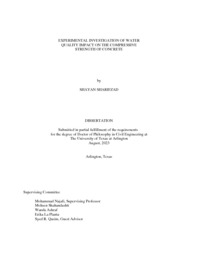
ATTENTION: The works hosted here are being migrated to a new repository that will consolidate resources, improve discoverability, and better show UTA's research impact on the global community. We will update authors as the migration progresses. Please see MavMatrix for more information.
Show simple item record
| dc.contributor.advisor | Najafi, Mohammad | |
| dc.creator | Sharifzad, Shayan | |
| dc.date.accessioned | 2023-09-27T16:32:14Z | |
| dc.date.available | 2023-09-27T16:32:14Z | |
| dc.date.created | 2023-08 | |
| dc.date.issued | 2023-08-31 | |
| dc.date.submitted | August 2023 | |
| dc.identifier.uri | http://hdl.handle.net/10106/31750 | |
| dc.description.abstract | Water is an indispensable component in concrete, as it enables crucial chemical reactions. Therefore, the quality of water used in concrete plays a vital role in its performance. Contaminated water, sewage, or high-salt water can disrupt the cement's setting process and overall performance. As a result, it is crucial to prioritize the use of drinking water or water of equivalent quality in concrete production. While the ideal water-to-cement ratio for concrete is typically around 0.20, practical considerations often require a higher water content ranging from 0.30 to 0.70. This increased water consumption is necessary to ensure workability and achieve optimal concrete performance. Notably, existing research lacks investigation into the combined effects of total dissolved solids (TDS) concentrations and pH values on concrete. Although previous studies have focused on the effects of sodium chloride on concrete performance, particularly regarding corrosion, none have simultaneously examined the effects of TDS concentrations at different pH levels. Furthermore, even though current research articles discuss suitable water quality for concrete production in general, a need still exists to statistically validate specific ranges of water quality parameters through laboratory investigations. This dissertation investigates the minimum acceptable compressive strength of concrete under varying concentrations of total dissolved solids (TDS) in both alkaline and acidic environments. The primary objective is to examine the impact of different TDS concentrations on the compressive strength of concrete across different pH ranges. The secondary objective is to identify the maximum permissible TDS concentrations that can ensure the desired compressive strength. This experimental investigation follows a methodology to examine the effects of TDS concentrations and pH levels on the compressive strength of concrete. Concrete samples are prepared using different TDS concentrations, including 1,000 ppm, 2,000 ppm, and 3,000 ppm, up to 4,000 ppm, while pH levels are controlled at 6 and 8. A total of 102 specimens were cast and cured for 3 days, 7 days, and 28 days. The compressive strengths of the concrete samples were measured at regular intervals to assess the influence of TDS and pH on the performance of the concrete. In conclusion, this research addresses a critical gap in the literature by investigating the combined effects of TDS concentrations and pH levels on the compressive strength of concrete. By statistically validating specific ranges of quality parameters through laboratory investigations, the study aims to provide practical insights into the maximum permissible TDS concentration that ensures the desired compressive strength. The results of this research will contribute to a better understanding of the influence of water quality on concrete compressive strength and help guide the development of sustainable concrete production practices. Due to limited time and resources, this dissertation does not provide conclusive results, but provides an insight for possible utilization of non-drinking water for concrete mix design without sacrificing its compressive strength. | |
| dc.format.mimetype | application/pdf | |
| dc.language.iso | en_US | |
| dc.subject | TDS | |
| dc.subject | pH | |
| dc.subject | Compressive strength | |
| dc.subject | Concrete | |
| dc.subject | Water quality | |
| dc.title | EXPERIMENTAL INVESTIGATION OF WATER QUALITY IMPACT ON THE COMPRESSIVE STRENGTH OF CONCRETE | |
| dc.type | Thesis | |
| dc.date.updated | 2023-09-27T16:32:14Z | |
| thesis.degree.department | Civil Engineering | |
| thesis.degree.grantor | The University of Texas at Arlington | |
| thesis.degree.level | Doctoral | |
| thesis.degree.name | Doctor of Philosophy in Civil Engineering | |
| dc.type.material | text | |
| dc.creator.orcid | 0009-0008-1520-7174 | |
Files in this item
- Name:
- SHARIFZAD-DISSERTATION-2023.pdf
- Size:
- 11.58Mb
- Format:
- PDF
This item appears in the following Collection(s)
Show simple item record


